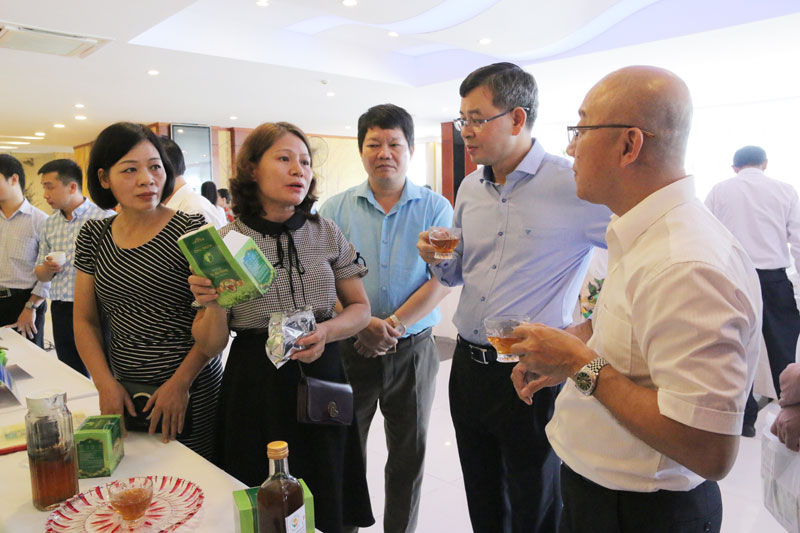
(HBO) – The association of farmers of Hoa Binh province coordinated with the Vietnamese conglomerate Vingroup to organise a conference to connect production and sales of local agricultural products on October 11.
The event saw the participation of key officials from the
provincial departments, association and organisations as well as leaders from
Vingroup and representatives of its trade centres. Vice Secretary of the
provincial Party Committee Ngo Van Tuan chaired the conference.
 Vice
Secretary of the provincial Party Committee Ngo Van Tuan visits a pavilion
showcasing local farm produce.
Vice
Secretary of the provincial Party Committee Ngo Van Tuan visits a pavilion
showcasing local farm produce.
In 2017-2019, the provincial People’s Committee
approved a list of 31 projects linking chain production with a total funding of
over 30 billion VND from the local rural area programme. Effective
production-sale connection models could be named as Song
Da fish, Lac Thuy and Lac Son chicken, Cao Phong orange, which are
produced towards increasing quality and brand management.
Representatives from Vingroup introduced its
Vineco and Vinmax systems and proposed some conditions to connect production
and sales of products, which should meet the following basic criteria: meeting
food safety standards according to Vietnamese Good Agricultural Practices
(VietGAP), having cooperatives or businesses organising production and sales of
products, ensuring packaging and traceability of products.
Vice Secretary of the provincial Party Committee
Ngo Van Tuan asked the local agricultural sector to push ahead with
restructuring and promoting local specialities in association with geographical
indications; organising communications and inspecting the implementation of
policies on capital and land; reforming and developing production models and
building concentrated material zones; improving processing, preserving,
packaging, and labelling capacity to increase the value of products; and
improving business investment environment.
He suggested regularly organising trade
promotion activities and introducing local special farm produce as well as
developing agricultural value chains. Businesses must be committed to creating
high-quality products, while relevant agencies and departments study to
establish working groups to support sales of farm produce.
The official hoped Vingroup would provide
technical assistance for the province and assist in producing, cultivating and
trading products.
At the conference, Vingroup leaders along with
representatives from local businesses and association of farmers signed a
memorandum of understanding on cooperation./.
According to data from the Hoa Binh Provincial Party Committee, the industrial production index for the first six months of 2025 is estimated to have increased by 20% compared to the same period last year. This marks the highest year-on-year growth rate for this period since 2020.
In the first six months of 2025, Hoa Binh province’s export turnover was estimated at 1.145 billion USD, marking an 18.11% increase compared to the same period in 2024. Import turnover was estimated at $ 804 million, a 17.15% increase, which helped the province maintain a positive trade balance.
The lives of the ethnic minority farmers in Tan Lac district have gradually improved thanks to the new directions in agricultural production. This is a testament to the collective strength fostered through the professional associations and groups implemented by various levels of the district’s Farmers’ Union.
With the motto the "product quality comes first,” after nearly one year of establishment and operation, Muong village’s Clean Food Agricultural and Commercial Cooperative, located in Cau Hamlet, Hung Son Commune (Kim Boi district), has launched reputable, high-quality agricultural products to the market that are well-received by consumers. The products such as Muong village’s pork sausage, salt-cured chicken, and salt-cured pork hocks have gradually carved out a place in the market and they are on the path to obtaining the OCOP certification.
In the past, the phrase "bumper harvest, rock-bottom prices" was a familiar refrain for Vietnamese farmers engaged in fragmented, small-scale agriculture. But today, a new spirit is emerging across rural areas of Hoa Binh province - one of collaboration, organisation, and collective economic models that provide a stable foundation for production.
Maintaining growing area codes and packing facility codes in accordance with regulations is a mandatory requirement for agricultural products to be eligible for export. Recently, the Department of Agriculture and Environment of Hoa Binh province has intensified technical supervision of designated farming areas and packing facilities to safeguard the "green passport" that enables its products to access international markets.



 Vice
Secretary of the provincial Party Committee Ngo Van Tuan visits a pavilion
showcasing local farm produce.
Vice
Secretary of the provincial Party Committee Ngo Van Tuan visits a pavilion
showcasing local farm produce.